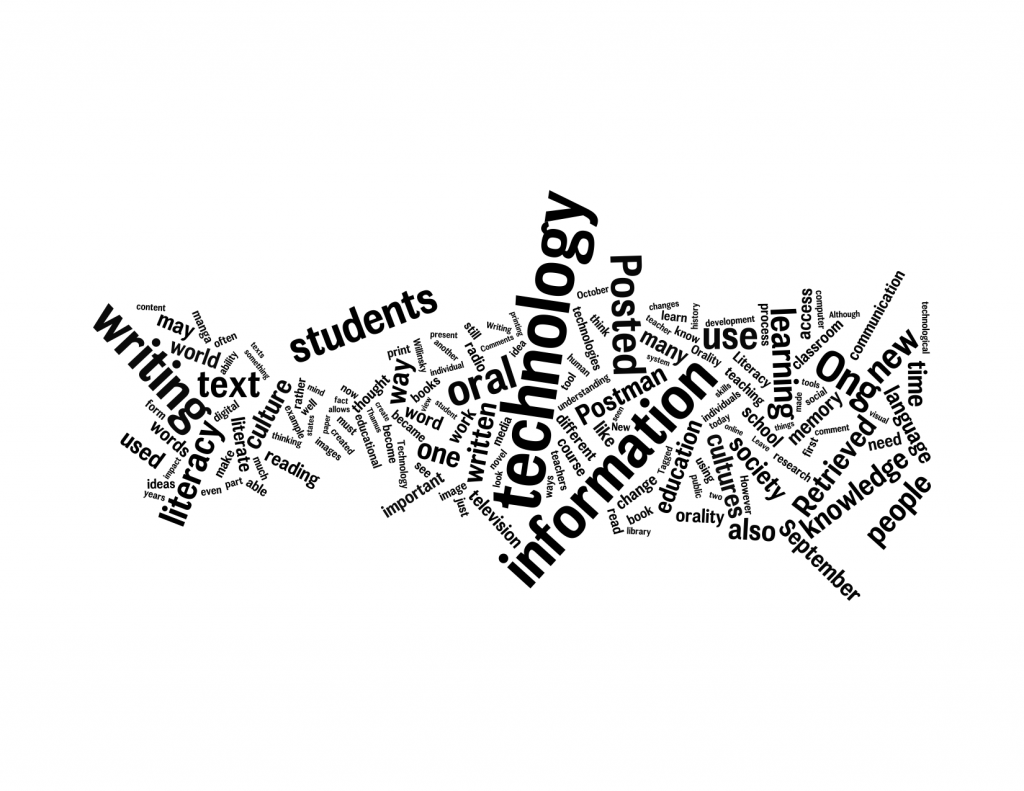In reading this past week’s reading and the glut of information we are receiving, especially text based information, made me think. What are the affordances that this has brought to our online courses? There is a lot more reading than in face to face classes (that I remember taking). We did the class readings, then we did our written work. There is so much more reading presented to us, that it is impossible to read it all. We have all of our own work, on top of that of our teammates and peers. I have compressed this blog from this semester into 2 minutes and 40 seconds. This doesn’t include the discussion groups, comments on social book or outside websites that we linked to. Here it is:
I also entered all of this text into wordle. As a class, our writing was dominated by technology, literacy, orality and writing. Below is a word cloud of all of the blog entries that we made in this class.
Unlike Bolter, I don’t think we are in the late age of print. We are in the “early age of print”. We have been confined to inks and paper, stuck within a frame in the physical world. Outside of means of production (the printing press), the technical evolution has been slow – and the paradigm has stayed the same. We are now moving from the horse and buggy to the automobile. We are just starting to see the potential of text once it is unbound, digitally manipulated, stored, shared and massively networked.
This digital explosion has expanded our understanding of literacy beyond just reading and writing. We spent a fair amount of time talking about the transition of Oral to written culture and the introduction of the image in the 19th century. Dan’s look at the poster (The Modern Poster is Born) showed the begining of an aesthetic that combines text and images that continues in web design today. The poster’s rich with imagery invited a less literate populace to participate in a more visual form of communication. Posters are still used in education today where scientists present concepts in visual, brief and understandable forms. Radio and television brought forth a new age of orality, where we could choose when the affordance of text was best suited and where the audio/visual was.
The graphic novel, which Colleen’s YouTube video explored also allowed for visual literacy to dominate and bring film and television “grammar” to the printed page. The reduction of cost to access the printed word has evolved from popular culture of comic books and penny newspapers, to a complex online world where the cultural walls between high culture and low culture have vanished. (Bolter, chapter 10) This combined with low cost electronic devices has brought literacy to more people than ever before. “However it is important to note that before the invention of the printing press, literacy was a privilege for only the upper class. The Church controlled not only what was read, but who was allowed to read it.” (mbourdon)
Now with digital technology, the students can become the authors and not just consumers. In Yuki, Christina and Collen’s Graphic Novels in the Classroom they explore various techniques that students can create their own graphic novels with ZooBurst, Go!Animate and Pixton. They tie this to the curriculum, but are also turning students from consumers to creators. The digital revolution lessens the role of the publisher and allows everyone to participate in our social dialogue, through many different means.
The flipped classroom is possible because of the affordances of the internet. Why recreate the same information over and over again in the classroom if it is easily accessible on the internet. Flipped learning enables Production Group Work where students can form an understanding in a team environment. This helps students work towards solving real world problems which are usually done in teams.
As a final thought, it would be good to balance the readings in the class of a critique of these post modern times with a counterweight of techniques for dealing with our current status. It is one thing to look at the changes critically, but we are all in the midst of coping with this revolution. Balancing readings that suggest how we can cope and adjust to this new reality would be useful.
I wish everyone a very happy holiday season, and hope to see you in January!
MarcA


Thanks for providing those, Marc, it’s amazing to look at the groupthink like that.
Thanks Jessica, it was fun just plugging it into wordle and seeing what words we used the most. It ironically aligned with the core aspects of the class, which just goes to show you that we stayed on topic 🙂
Hi Marc,
Good job interjecting your final connection piece with work from others in the class. It provided a richer context to your point of view. You also have a great break.
Lisa